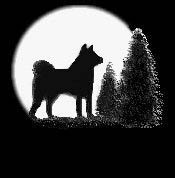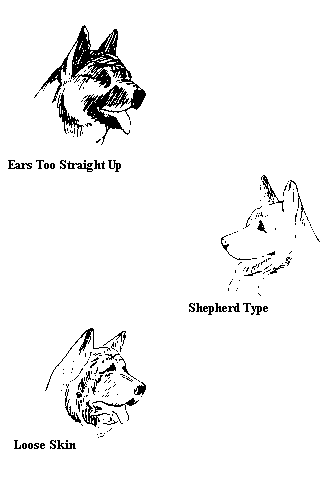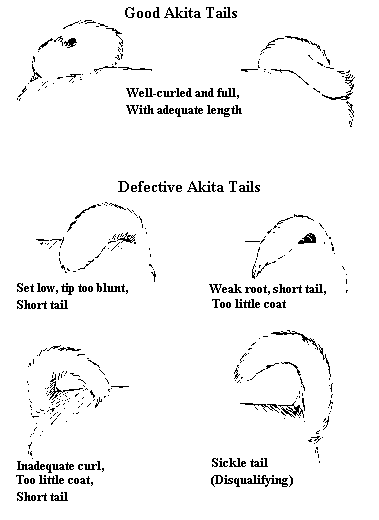|

 
 
 
 
 
 
 

|
The AKC Akita Standard
INTRODUCTION
If it were necessary to describe
the Akita in one word, "dignity" would suffice, for
it is this concept that the breed embodies. Whether in proud
stance or no-nonsense movement, the breed's dignified presence
is its most distinct quality. Each element described in the standard
is designed to contribute to this impression.
There is an emphasis in Akita
standards on the head. The overall broad and triangular head
shape is brought to extraordinary impressiveness by the harmonizing
triangular shape of the eyes and ears. The product is an alert
and fearless expression.
As a balancing agent, there
is a large, full tail. It cannot trail behind or up in the air
but must curl around to meet the dog's back or rest against his
flank.
The Akita is in the bottom range
of the large-size breed category. His size and obvious strength
leave a lasting impression on all who see him. At the same time,
there is no harshness in his appearance, for the short, thick
and lustrous double coat softens the rugged outline of muscle
and bone.
In his driving movement, the
Akita combines great power with a precision and smoothness, which
makes it seem as natural to be moving as to be standing still.
Every step is a purposeful expression of the dog's own will.
The breed character is reserved,
silent, and dominant over other canines. Although the Akita is
unruffled by minor irritations, he is alert toward other dogs,
and any serious challenge is met with swift retaliation.
With man, the Akita is a delightful
companion. He gives in devotion and protection more than he could
ever take in food and shelter. Friendly strangers are treated
with respect, but trespassers find the door barred by an awesome
figure.
THE
STANDARD
GENERAL APPEARANCE
Large, powerful, alert, with
much substance and heavy bone. The broad head, forming a blunt
triangle, with deep muzzle, small eyes and erect ears carried
forward in line with back of neck, is characteristic of the breed.
The large, curled tail, balancing the broad head, is also characteristic
of the breed.
HEAD
Massive but in balance with
body, free of wrinkle when at ease. Skull flat between ears and
broad; jaws square and powerful with minimal dewlap. Head forms
a blunt triangle when viewed from above. Fault: Narrow or snippy
head.
MUZZLE
Broad and full. Distance from
nose to stop is to distance from stop to occiput as 2 is to 3.
Stop well defined, but not too abrupt. A shallow furrow extends
well up forehead.
NOSE
Broad and Black. Liver permitted
on white Akitas, but black always preferred. Disqualification:
Butterfly nose or total lack of pigmentation on nose.

EARS
The ears of the Akita are
characteristic of the breed. They are strongly erect and small
in relation to rest of head. If ear is folded forward for measuring
length, tip will touch upper eye rim. Ears are triangular, slightly
rounded at tip, wide at base, set wide on head but not too low,
and carried forward over eyes in line with back of neck. Disqualification:
Drop or broken ears.
EYES
Dark brown, small, deep-set
and triangular in shape. Eye rims black and tight.
LIPS/TONGUE
Lips black and not pendulous,
tongue pink.
TEETH
Strong with scissors bite
preferred, but level bite acceptable. Disqualification: Noticeably
undershot or overshot.

NECK
Thick and muscular; comparatively
short, widening gradually toward the shoulders. A pronounced
crest blends in with base of skull.
BODY
Longer than high, as 10 is
to 9 in males; 11 to 9 in bitches. Chest wide and deep; depth
of chest is one-half height of dog at shoulder. Level back with
firmly muscled loin and moderate tuck-up. Skin pliant but not
loose. Serious fault: Light bone, rangy body.

TAIL
Large and full, set high and
carried over back in a three- quarter, full, or double curl,
always dipping to or below level of back. On a three-quarter
curl, tip drops well down flank. Root large and strong. Tail
bone reaches hock when let down. Hair coarse, straight and full,
with no appearance of a plume. Disqualification: Sickle or uncurled
tail.
Tails should be well-curled
and full, with adequate length. Defective tails shown are: 1)set
low, tip too blunt, short tail; 2) weak root, short tail, too
little coat; 3) inadequate curl, too little coat, short tail;
and 4) sickle tail (disqualification).

FOREQUARTERS
Shoulders strong and powerful
with moderate layback. Forelegs heavy-boned and straight as viewed
from the front. Angle of pastern 15 degrees forward from vertical.
Faults: Elbows in or out, loose shoulders.

HINDQUARTERS
Width, muscular development
and bone comparable to forequarters. Upper thighs well developed.
Stifle moderately bent and hocks well let down, turning neither
in or out.
DEWCLAWS
on front legs generally not
removed; on hind legs generally removed. Feet - cat feet, well
knuckled up with thick pads. Feet straight ahead.
COAT
Double-coated. Undercoat thick,
soft, dense and shorter than outer coat. Outer coat straight,
harsh and standing somewhat off body. Hair on head, legs and
ears short. Length of hair at withers and rump approximately
two inches, which is slightly longer than on rest of body, except
tail, where coat is longest and most profuse. Fault: Any indication
of ruff feathering.
COLOR
Any color including white,
brindle, or pinto. Colors are brilliant and clear and markings
are well balanced with or without mask or blaze. White Akitas
have no mask. Pinto has a white background with large, evenly
paced patches covering head and more than one-third of body.
Undercoat may be a different color from outer coat.
GAIT
Brisk and powerful with strides
of moderate length. Back remains strong, firm and level. Rear
legs move in line with front legs.
SIZE
Males 26 to 28 inches at the
withers; bitches 24 to 26 inches. Disqualification: Dogs under
25 inches, bitches under 23 inches.
TEMPERAMENT
Alert and responsive, dignified
and courageous. Aggressive towards other dogs.
DISQUALIFICATIONS
Butterfly nose or total lack
of pigmentation on nose.
Drop or broken ears.
Noticeably undershot or overshot.
Sickle or uncurled tail.
Dogs under 25 inches; bitches under 23 inches.
POINTS
TO REMEMBER
The Akita is broad and powerful.
This quality is more evident in dogs than in bitches.
Reflecting the moderate degree
of angulation in shoulder and stifle, the Akita's brisk and powerful
gait is characterized by strides of moderate length.
Akita ears are different from
those of any other breed. They are small, set well apart on the
broad head, and angled forward at about 45 degrees from the vertical.
Ears are strongly erect.
Most Akitas have no loose skin
on their heads at any time. Under conditions of excitement, a
slight wrinkle on the forehead is acceptable but not desirable.
Characteristic of the breed is a furrow down the center of the
forehead. Loose and sagging lips are incorrect.
The Akita eye is small, dark
in color and triangular in shape.
The Akita's impressive tail
is a vital element in the total picture he presents. It is large
and full to balance his imposing head. When the tail is brought
down, the tail bone reaches the hock joint.
The Akita topline is perfectly
level, whether standing or moving.
Rich, clear colors are desirable.
Especially with pintos, well-balanced markings are vital to the
overall appearance.
The neck is thick and strong,
with a pronounced crest.
Splayed feet or long toes are
incorrect.
The Akita's double coat is thick
and dense. The outer coat is harsh but not wiry. The undercoat
is soft.
The only acceptable bites are
scissors (upper teeth barely overlap lower teeth in front) and
level (upper teeth meet lower teeth exactly).
|

